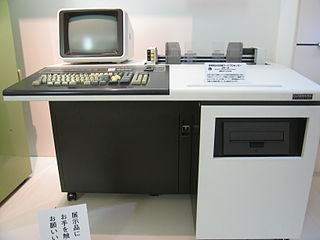This article needs additional citations for verification .(February 2017) (Learn how and when to remove this template message) |
Office/36 was a suite of applications marketed by IBM from 1983 to 2000 for the IBM System/36 family of midrange computers. IBM announced its System/36 Office Automation (OA) strategy in 1985. [1]

International Business Machines Corporation (IBM) is an American multinational information technology company headquartered in Armonk, New York, with operations in over 170 countries. The company began in 1911, founded in Endicott, New York, as the Computing-Tabulating-Recording Company (CTR) and was renamed "International Business Machines" in 1924. IBM is incorporated in New York.
A computer is a machine that can be instructed to carry out sequences of arithmetic or logical operations automatically via computer programming. Modern computers have the ability to follow generalized sets of operations, called programs. These programs enable computers to perform an extremely wide range of tasks. A "complete" computer including the hardware, the operating system, and peripheral equipment required and used for "full" operation can be referred to as a computer system. This term may as well be used for a group of computers that are connected and work together, in particular a computer network or computer cluster.
Office/36 could be purchased in its entirety, or piecemeal. Components of Office/36 include: [2] [3] [4]
- IDDU/36, the Interactive Data Definition Utility.
- Query/36, the Query utility.
- DisplayWrite/36, [5] a word processing program.
- Personal Services/36, [5] a calendaring system and an office messaging utility.
Query/36 was not quite the same as SQL, but it had some similarities, especially the ability to very rapidly create a displayed recordset from a disk file. Note that SQL, also an IBM development, had not been standardized prior to 1986.
SQL is a domain-specific language used in programming and designed for managing data held in a relational database management system (RDBMS), or for stream processing in a relational data stream management system (RDSMS). It is particularly useful in handling structured data, i.e. data incorporating relations among entities and variables.
DisplayWrite/36, in the same category as Microsoft Word, had online dictionaries and definition capabilities, and spell-check, and unlike the standard S/36 products, it would straighten spillover text and scroll in real time.

Microsoft Word is a word processor developed by Microsoft. It was first released on October 25, 1983 under the name Multi-Tool Word for Xenix systems. Subsequent versions were later written for several other platforms including IBM PCs running DOS (1983), Apple Macintosh running the Classic Mac OS (1985), AT&T Unix PC (1985), Atari ST (1988), OS/2 (1989), Microsoft Windows (1989), SCO Unix (1994), and macOS.
Considerable changes were required to S/36 design to support Office/36 functionality, not the least of which was the capability to manage new container objects called "folders" and produce multiple extents to them on demand. Q/36 and DW/36 typically exceeded the 64K program limit of the S/36, both in editing and printing, so using Office products could heavily impact other applications. DW/36 allowed use of bold, underline, and other display formatting characteristics in real time.







